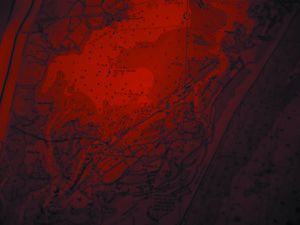We could read the charts far more quickly under dim white light and made far fewer mistakes. But neither is easy if the light is sufficiently dim. These photos understate the difference in the human eye’s ability to detect fine detail in very dim red vs. white light. They primarily show the difference in color rendition.

- Red chart markings, such as this compass rose, are still legible under red light because they are actually magenta.

2. Shades of blue, green, and tan are all grey under red light, interfering with the navigator’s ability to distinguish features.

3. Through a basic neutral filter light is more concentrated. The lack of uniformity means your eye, as with a red light that obscures some colors, again has to work harder to distinguish features.

4. Any evenly diffused white light has been proven to be easier on the eyes in several studies. When properly dimmed, it will not interfere with night vision. The exposure of this photo was boosted for printing, so it is actually darker than it appears.






























